The 2013 MacBook Air Review (13-inch)
by Anand Lal Shimpi on June 24, 2013 12:01 AM ESTCPU Performance
To measure CPU performance we begin with a fairly standard measure of system responsiveness: boot time. With the last generation of upgrades to 6Gbps SATA, we saw a good decrease in boot time over the previous generation platforms. The new 13-inch MBA's PCIe SSD takes the crown as it boots ever so slightly quicker than last year's setup. In practice the difference is subtle, but something you can appreciate as the 2013 MBA's IO is just snappier all over.
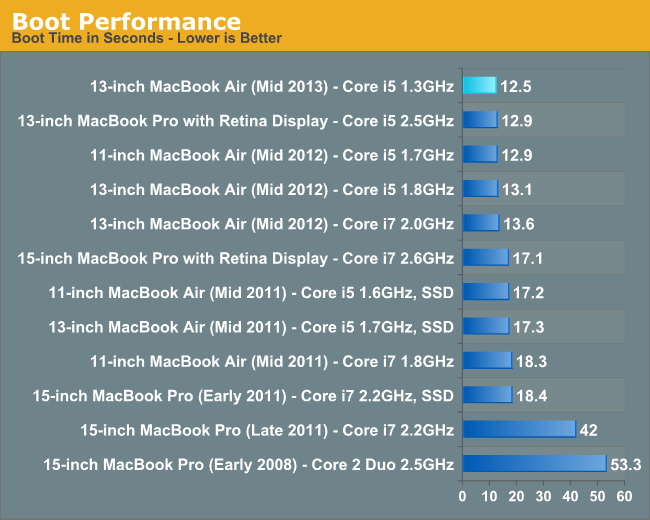
These next two charts look at single and multithreaded floating point performance using Cinebench 11.5. This test also gives us the rare opportunity of comparing to some older Mac Pro hardware as well from 2008 - 2010. Single threaded performance remains extremely important to overall system responsiveness, so it's always good to look at. As we found in our initial look at the new MBA, the 1.3GHz Core i5 CPU ends up performing about the same as last year's 1.8GHz part. I'd like to say it's all because of cooling and turbo boost, but in all likelihood Apple is trading some of Haswell's IPC gains for frequency here - enabling identical performance, at lower clocks thanks to Haswell's more efficient architecture.
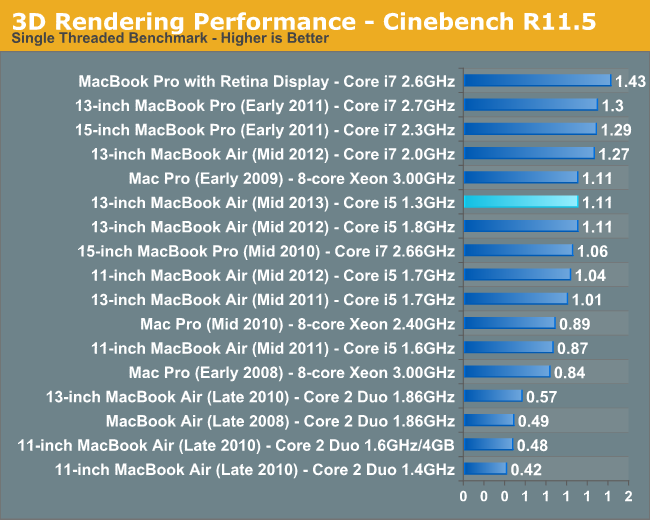
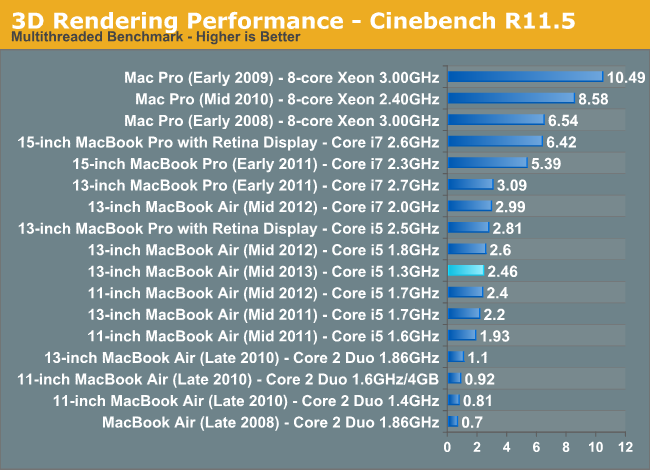
The multithreaded performance story is a bit different. The 1.3GHz i5 regresses in performance by about 5%. Overall performance is still quicker than the 2011 models, as well as the i7 based 11-inch MBA from 2012. Here we're simply seeing the 15W TDP limits come into play. Sharing both PCH and dual-core CPU power in a lower thermal footprint than last year's CPU alone is responsible for what we see above.
Video transcoding is really best suited for the higher end machines, but that doesn't change the fact that it's done on MacBook Airs as well. We'll start by looking at performance under iMovie. Here we're importing 1080p video from a Nikon D7000 and optimizing it during import.
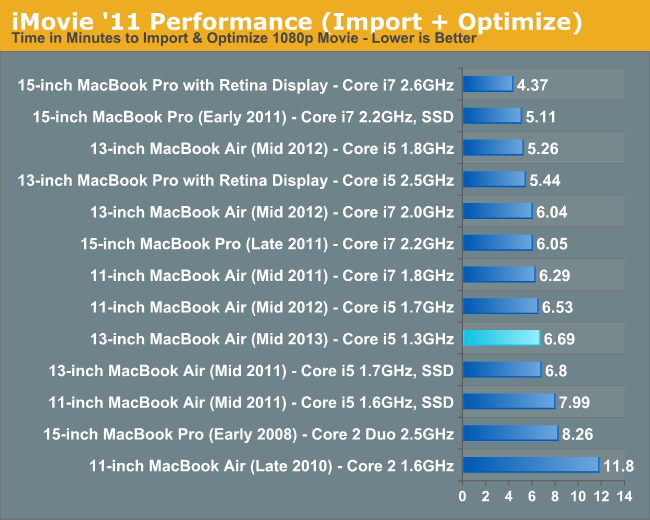
The 13-inch 1.3GHz Core i5 configuration performs similarly to last year's 11-inch 1.7GHz config. It's an interesting comparison because the 11-inch 2012 model is more thermally constrained than the 13-inch 2012 model, which is exactly what we see when we compare the 2013 13-inch MBA to the 2012 13-inch MBA. In this case the 2013 model is a hair quicker than the 2011.

We see a similar story for a full video export. The 1.3GHz 2013 MBA slots in behind the 2011 model in this CPU bound test.
Final Cut Pro X falls on the professional end of the video production spectrum. The test file is the same here, but the workload is far more strenuous.
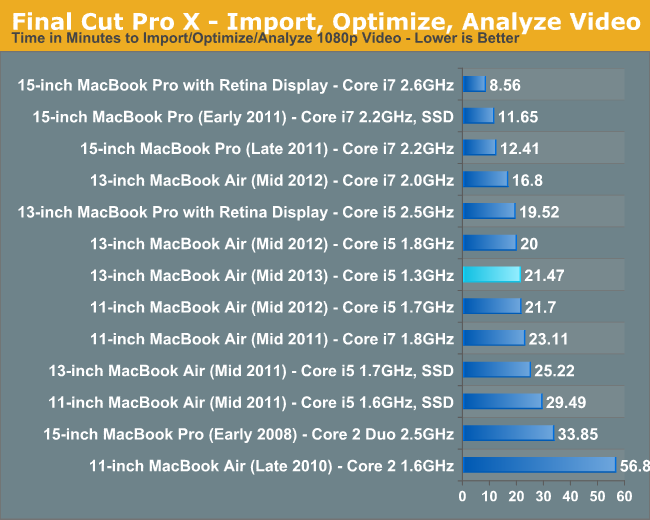
Once again, we see roughly the same performance from the 13-inch 2013 1.3GHz i5 as the 11-inch 2012 MBA. Here we do see substantially better performance than the 2011 models.
Our two photo workloads generally agree with what we saw in the video tests. The 1.3GHz Haswell part is definitely slower than th e previous generation 1.7/1.8GHz SKUs:
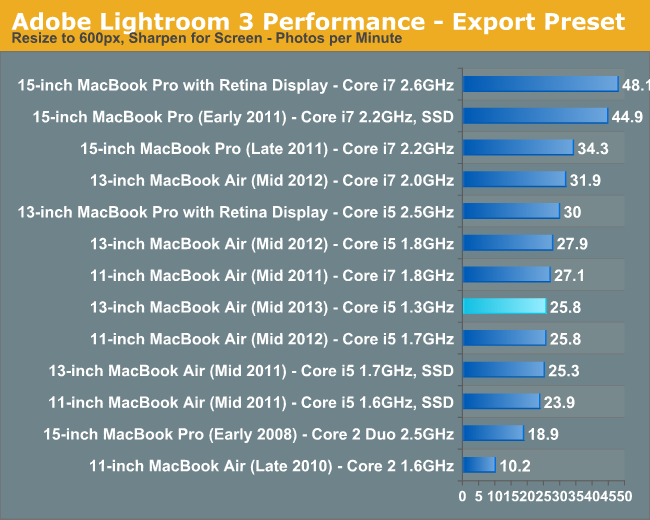
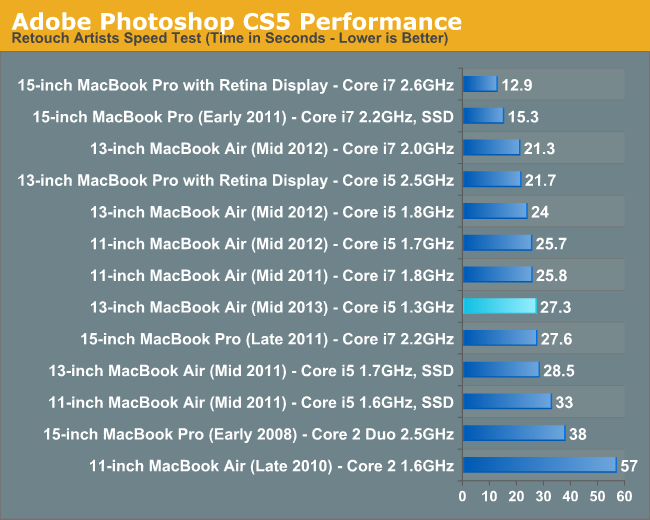
In our desktop review of Haswell I noted that performance in our compile test improved tremendously with the new architecture. As it's quite obvious that Haswell's IPC advantages don't surface all that much in our traditional suite, I wanted to see if perhaps things would be different in something that might lend itself better to Haswell's IPC improvements. I repeated our Firefox build test but under OS X. It's a multithreaded compile, with the number of threads set to 2x the number of cores (not threads) in a system. Unfortunately I came up with this bright idea while traveling, so I only had access to three machines: the 2013 13-inch MBA, the 15-inch rMBP and a 2GHz Core i7 2012 13-inch MBA. I'll add more results later, but I'm expecting this to be a part of our test suite going forward.

The combination of Haswell and a really fast SSD appears to help narrow the gap between the much higher clocked 2012 model and the base 2013 13-inch MBA. Here the faster Ivy Bridge CPU is less than 2% quicker. I'll reserve final judgements until I get my hands on the 1.7GHz Core i7 model, but my guess is this is an example of the best case scenario for Haswell where you get equivalent performance to a higher clocked Ivy Bridge part but with much better thermal/noise/battery life characteristics. For example, the fan was never audible on the 2013 MBA while running this test compared to running at a very noticeable volume on the 2012 Core i7 model. The same goes for temperatures. The i7 2012 model tends to run about 5% warmer along the bottom of the chassis compared to the 2013 i5.










233 Comments
View All Comments
p1esk - Monday, June 24, 2013 - link
At longer length or if there are electrical interferences, Cat6 will be better for 1Gbps than Cat5e.spronkey - Monday, June 24, 2013 - link
Technically Cat5e doesn't have to reach 1Gbps at 100m lengths, which is the 1Gbps standard. So, Cat6 is the 1Gbps standard :PA5 - Monday, June 24, 2013 - link
Though you'd have to buy some seriously cheap Cat5e to get something that doesn't hit that spec. But yeah, if you're going in-wall you may as well go Cat6 for when you want a 10G network.Mikad - Monday, June 24, 2013 - link
Thanks for the review.If it's at some point updated with i7 battery life results, it would be great if you could run the battery tests in Windows + Bootcamp also. Some sites have done this, like Pcper, and there has been about 50% decrease in battery life. It would be great to have some kind of an analysis why the battery life takes such a hit in Windows.
IntelUser2000 - Monday, June 24, 2013 - link
Because the battery life gains due to Haswell are based on how well the components are cooperating together, and sub-optimal drivers would easily cancel the improvements out.That's why you see Haswell Windows Ultrabooks do pretty good, but Macbook Air running Windows isn't doing so well.
Glindon - Monday, June 24, 2013 - link
I don't think it really has much to do with drivers. There's nothing special about the components compared to a Windows ultra book. I think it boils down to something at the EFI level and Apple isn't going to prioritize it for a small subset of users. I'm guessing that running Windows in a VM (through Parallels) might give better battery life.darwinosx - Monday, June 24, 2013 - link
Yes there is. Which you would know if you read the articleApple uses custom sad, motherboard, chipsets and a few other compoenents. Thats why the sad is so much faster for example.
erple2 - Monday, June 24, 2013 - link
That, BTW, was one of the greatest autocorrects I've seen in a while. Full of fast sad indeed.Bkord123 - Tuesday, June 25, 2013 - link
hahaha!!!Mikad - Monday, June 24, 2013 - link
I've seen the drivers mentioned as the reason before, but as Glindon stated, the components are just the standard PC stuff, found in other ultrabooks. The drivers are probably the same too.